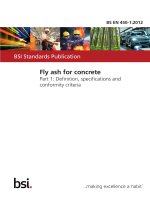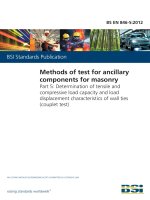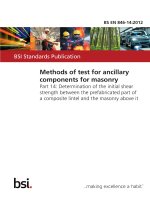Bsi bs en 62047 14 2012
Bạn đang xem bản rút gọn của tài liệu. Xem và tải ngay bản đầy đủ của tài liệu tại đây (1.33 MB, 22 trang )
BS EN 62047-14:2012
BSI Standards Publication
Semiconductor devices —
Micro-electromechanical
devices
Part 14: Forming limit measuring method
of metallic film materials
BRITISH STANDARD
BS EN 62047-14:2012
National foreword
This British Standard is the UK implementation of EN 62047-14:2012. It is
identical to IEC 62047-14:2012.
The UK participation in its preparation was entrusted to Technical Committee
EPL/47, Semiconductors.
A list of organizations represented on this committee can be obtained on
request to its secretary.
This publication does not purport to include all the necessary provisions of a
contract. Users are responsible for its correct application.
© The British Standards Institution 2012
Published by BSI Standards Limited 2012
ISBN 978 0 580 72297 4
ICS 31.080.99
Compliance with a British Standard cannot confer immunity from
legal obligations.
This British Standard was published under the authority of the Standards
Policy and Strategy Committee on 31 May 2012.
Amendments issued since publication
Amd. No.
Date
Text affected
BS EN 62047-14:2012
EUROPEAN STANDARD
EN 62047-14
NORME EUROPÉENNE
April 2012
EUROPÄISCHE NORM
ICS 31.080.99
English version
Semiconductor devices Micro-electromechanical devices Part 14: Forming limit measuring method of metallic film materials
(IEC 62047-14:2012)
Dispositifs à semiconducteurs Dispositifs microélectromécaniques Partie 14: Méthode de mesure des limites
de formage des matériaux à couche
métallique
(CEI 62047-14:2012)
Halbleiterbauelemente Bauelemente der Mikrosystemtechnik Teil 14: Verfahren zur Ermittlung der
Grenzformänderung metallischer
Dünnschichtwerkstoffe
(IEC 62047-14:2012)
This European Standard was approved by CENELEC on 2012-04-03. CENELEC members are bound to comply
with the CEN/CENELEC Internal Regulations which stipulate the conditions for giving this European Standard
the status of a national standard without any alteration.
Up-to-date lists and bibliographical references concerning such national standards may be obtained on
application to the CEN-CENELEC Management Centre or to any CENELEC member.
This European Standard exists in three official versions (English, French, German). A version in any other
language made by translation under the responsibility of a CENELEC member into its own language and notified
to the CEN-CENELEC Management Centre has the same status as the official versions.
CENELEC members are the national electrotechnical committees of Austria, Belgium, Bulgaria, Croatia, Cyprus,
the Czech Republic, Denmark, Estonia, Finland, France, Germany, Greece, Hungary, Iceland, Ireland, Italy,
Latvia, Lithuania, Luxembourg, Malta, the Netherlands, Norway, Poland, Portugal, Romania, Slovakia, Slovenia,
Spain, Sweden, Switzerland, Turkey and the United Kingdom.
CENELEC
European Committee for Electrotechnical Standardization
Comité Européen de Normalisation Electrotechnique
Europäisches Komitee für Elektrotechnische Normung
Management Centre: Avenue Marnix 17, B - 1000 Brussels
© 2012 CENELEC -
All rights of exploitation in any form and by any means reserved worldwide for CENELEC members.
Ref. No. EN 62047-14:2012 E
BS EN 62047-14:2012
EN 62047-14:2012
-2-
Foreword
The text of document 47F/108/FDIS, future edition 1 of IEC 62047-14, prepared by SC 47F, "Microelectromechanical systems", of IEC TC 47, "Semiconductor devices" was submitted to the IEC-CENELEC
parallel vote and approved by CENELEC as EN 62047-14:2012.
The following dates are fixed:
•
•
latest date by which the document has
to be implemented at national level by
publication of an identical national
standard or by endorsement
latest date by which the national
standards conflicting with the
document have to be withdrawn
(dop)
2013-01-03
(dow)
2015-04-03
Attention is drawn to the possibility that some of the elements of this document may be the subject of
patent rights. CENELEC [and/or CEN] shall not be held responsible for identifying any or all such patent
rights.
Endorsement notice
The text of the International Standard IEC 62047-14:2012 was approved by CENELEC as a European
Standard without any modification.
-3-
BS EN 62047-14:2012
EN 62047-14:2012
Annex ZA
(normative)
Normative references to international publications
with their corresponding European publications
The following documents, in whole or in part, are normatively referenced in this document and are
indispensable for its application. For dated references, only the edition cited applies. For undated
references, the latest edition of the referenced document (including any amendments) applies.
NOTE When an international publication has been modified by common modifications, indicated by (mod), the relevant EN/HD
applies.
Publication
Year
Title
EN/HD
Year
IEC 62047-1
2005
Semiconductor devices - Microelectromechanical devices Part 1: Terms and definitions
EN 62047-1
2006
–2–
BS EN 62047-14:2012
62047-14 © IEC:2012
CONTENTS
1
Scope ............................................................................................................................... 5
2
Normative references ....................................................................................................... 5
3
Terms, definitions and symbols ........................................................................................ 5
4
3.1 Terms and definitions .............................................................................................. 5
3.2 Symbols .................................................................................................................. 6
Testing method ................................................................................................................. 6
5
4.1
4.2
4.3
Test
6
5.1 Test procedure ........................................................................................................ 8
5.2 Data analysis .......................................................................................................... 9
Test report...................................................................................................................... 10
General ................................................................................................................... 6
Equipment ............................................................................................................... 6
Specimen ................................................................................................................ 7
procedure and analysis ............................................................................................. 8
Annex A (informative) Principles of the forming limit diagram ............................................... 11
Annex B (informative) Grid marking method ......................................................................... 13
Annex C (informative) Gripping method ............................................................................... 15
Annex D (informative) Strain measuring method .................................................................. 17
Figure 1 – Equipment and tools for forming limit tests ............................................................. 7
Figure 2 – Rectangular specimens with six kinds of aspect ratio ............................................. 8
Figure 3 – Strain for forming limit measurement ...................................................................... 9
Figure 4 – Construct the forming limit diagram by plotting the major and minor strains .......... 9
Figure A.1 – Forming limit diagram ....................................................................................... 11
Figure A.2 – Hemispherical punch for forming limit measurement ......................................... 11
Figure A.3 – Grid for forming limit measurement ................................................................... 12
Figure A.4 – Loading path of the specimen with various aspect ratios ................................... 12
Figure B.1 – Procedure of a photographic grid marking method ............................................ 13
Figure B.2 – Procedure for an inkjet grid marking method ..................................................... 14
Figure C.1 – Gripping of the specimen using a ring shaped die ............................................. 15
Figure C.2 – Gripping of the specimen using adhesive bonding ............................................ 16
Figure D.1 – Set up for strain measurement using digital camera .......................................... 17
Figure D.2 – Example of pixel converting image of deformed specimen ................................ 17
Table 1 – List of letter symbols ............................................................................................... 6
BS EN 62047-14:2012
62047-14 © IEC:2012
–5–
SEMICONDUCTOR DEVICES –
MICRO-ELECTROMECHANICAL DEVICES –
Part 14: Forming limit measuring method
of metallic film materials
1
Scope
This part of IEC 62047 describes definitions and procedures for measuring the forming limit of
metallic film materials with a thickness range from 0,5 µm to 300 µm. The metallic film
materials described herein are typically used in electric components, MEMS and microdevices.
When metallic film materials used in MEMS (see 2.1.2 of IEC 62047-1:2005) are fabricated by
a forming process such as imprinting, it is necessary to predict the material failure in order to
increase the reliability of the components. Through this prediction, the effectiveness of
manufacturing MEMS components by a forming process can also be improved, because the
period of developing a product can be reduced and manufacturing costs can thus be
decreased. This standard presents one of the prediction methods for material failure in
imprinting process.
2
Normative references
The following documents, in whole or in part, are normatively referenced in this document and
are indispensable for its application. For dated references, only the edition cited applies. For
undated references, the latest edition of the referenced document (including any
amendments) applies.
IEC 62047-1:2005, Semiconductor devices – Micro-electromechanical devices – Part 1:
Terms and definitions
3
3.1
Terms, definitions and symbols
Terms and definitions
For the purposes of this document, the terms and definitions given in IEC 62047-1 and the
following apply.
3.1.1
circular grid
grid used for measuring the localized deformation of the specimens within the circle
3.1.2
grid patterns
pattern marked on the surface of the testing material permitting immediate and direct
measurement of the formability for the metallic film materials
Note 1 to entry
The grid consists of a pattern of small circles or rectangles.
3.1.3
major axis
longest line of the deformed elliptical shape, which passes through both focuses of the ellipse
BS EN 62047-14:2012
62047-14 © IEC:2012
–6–
3.1.4
minor axis
longest line of the deformed elliptical shape, which is perpendicular to the major axis
3.1.5
square grid
grid used for measuring the overall deformation of the testing material
3.2
Symbols
For the purpose of this document, letter symbols given in Table 1 are used.
Table 1 – List of letter symbols
Name and designation
Letter symbol
Grid size
– initial diameter of the grid before deformation
d0
– diameter of the grid along the major axis after deformation
d1
– diameter of the grid along the minor axis after deformation
d2
Strain
– major strain
ε1
– minor strain
ε2
Equipment, tool and specimen size
– diameter of the hemispherical punch
4
D punch
– inner diameter of the die hole
D die
– diameter of the bead ring
D bead
– fillet radius of the upper die edge
r de
– thickness of the testing specimen
t
– height of the testing specimen
h
– width of the testing specimen
w
Testing method
4.1
General
The forming limit diagram (FLD) is determined by pressing the micro film material using a
hemispherical punch. This pressing process is performed until the film material fractures. The
major and minor strains of a deformed specimen can be measured in many ways, for example,
by using a digital camera module or an optical device. However, using a digital camera
module with sufficient resolution and a high magnifying power lens is recommended.
NOTE
See Annex A for principles of forming limit diagram.
4.2
Equipment
Micro press equipment is utilized as the loading equipment for FLD tests as described in
Figure 1. A hemispherical punch is attached to the micro press to stretch the film material to
measure the forming limits of the specimen. Conventional hard chrome coating to the punch
surface using hexavalent chromium is recommended to guarantee a surface roughness less
than 0,8 µm (RMS: Root Mean Square). In addition, lubricants such as graphite can be
applied for reducing the friction force between the surfaces of the punch and the specimen.
The movement of the punch is controlled by a constant crosshead speed of the measuring
devices in the micro press. The punch speed shall be lowered to the quasi-static condition. A
punch speed of less than 20 µm/s is recommended in order not to result in the dynamic inertia
BS EN 62047-14:2012
62047-14 © IEC:2012
–7–
effect during the test. Although the dimension of the hemispherical punch and the test
samples can be varied with forming product and inspected measuring region, it is
recommended that the dimension should be determined as the following ratio.
D die = D punch + 2,5t
(1)
D bead = 2 × D punch
(2)
It is also recommended that the hemispherical punch diameter and the die edge radius should
be 5 mm and 0,5 mm respectively.
D
Dbead
bead
Ddie
D
die
1
11
de
rrde
3
33
2
22
DDpunch
punch
4
IEC 200/12
Key
1
upper die
2
lower die
3
specimen
4
hemispherical punch
Figure 1 – Equipment and tools for forming limit tests
4.3
Specimen
Rectangular specimens with different aspect ratios shall be used in the test. At least six kinds
of specimens with the aspect ratios of 1,0, 1,5, 1,75, 2,0, 3,5 and 7,0 are recommended as
shown in Figure 2 in order to cover the various loading paths on the domain of the forming
limit diagram.
h = 2,5 × D punch
(3)
BS EN 62047-14:2012
62047-14 © IEC:2012
–8–
Aspect ratio =
w
Specimen height (h)
Specimen width (w)
h
1
1,5
1,75
2
3,5
7
IEC 201/12
Figure 2 – Rectangular specimens with six kinds of aspect ratio
Grids shall be marked to the surface of the testing sample to measure the localized and
overall deformation of the film material. The grid consists of a pattern of small circles or
rectangles. It is recommended to arrange the grid patterns with an interval range from 50 µm
to 200 µm and that the thickness of the grid is less than 10 % of the specimen thickness.
NOTE
5
5.1
See Figure A.3 for detailed grid pattern.
Test procedure and analysis
Test procedure
In a FLD test, the following items from a) to e) are steps to obtain a localized fracture of a
specimen which is firstly observed. Then the values of a major strain and a minor strain which
are used to quantify the deformation of the specimen will be measured.
a) Preparation of the specimen
Specimens with different aspect ratios are prepared to conduct the test.
NOTE 1 Both the positive and negative region of the FLD curve can be obtained by varying the aspect ratio of
the specimen and the lubricant.
b) Grid marking on the specimen
Appropriate marking conditions which have a lesser effect on the microstructure and the
properties of materials should be applied in the grid marking since the thickness of the film
is relatively smaller.
NOTE 2
See Annex B for detail expression of several grid marking methods.
c) Gripping the specimen
In order to measure the strain only in the testing region, it is important that the sample
should be clamped without any sliding. Also, pre-fracture should not occur when it is being
clamped.
NOTE 3
See Annex C for several recommended gripping methods.
d) Moving the punch until the specimen fails
The hemispherical punch moves by controlling the constant crosshead speed of
equipment until the localized fracture of the specimen is first observed.
e) Measuring the major and minor strains of deformed specimen
Major and minor strains of the deformed specimen are measured representatively using
the digital camera module with a high magnifying power lens. The recommended
magnification factor of the camera lens is less than 5 µm/pixel in order to measure the
strain precisely.
NOTE 4
f)
See Annex D for strain measuring method.
Construct the FLD by plotting the measured major and minor strains (refer to Figure 4).
62047-14 © IEC:2012
5.2
–9–
Data analysis
In order to quantify the deformation of the specimen, two kinds of strains – major and minor
strains – are measured between the initial state of the circle and the deformed elliptical shape.
After the circular grid deforms, the longest dimensions of the ellipse is major axis and the
dimension perpendicular to the major axis is the minor axis, as explained in Figure 3.
Minor
Minoraxis
Axis
Major axis
Major
Axis
IEC 202/12
Figure 3 – Strain for forming limit measurement
The major strain, ε 1 , and the minor strain, ε 2 , are calculated with following equations:
ε 1 = ln
d1
d0
(4)
ε 2 = ln
d2
d0
(5)
Here, d 0 is the initial diameter of the circular grid while d 1 and d 2 represent the major and the
minor diameters of the grid after deformation.
Major
Majorstrain
strainε1ε(%)
1 [%]
80
3
3
70
33
33
60
3
3
50
22
40
22
1
1
3
3
2
2
30
22
20
22
10
-40
-30
-20
-10
0
10
Minorstrain
strainε2ε(%)
Minor
2 [%]
Key
1
fracture
2
good
3
failure
Figure 4 – Construct the forming limit diagram
by plotting the major and minor strains
20
30
40
IEC 203/12
– 10 –
BS EN 62047-14:2012
62047-14 © IEC:2012
The major and minor strains calculated from the grids in the neighbourhood of the failure zone
of the specimen are regarded as critical failure strains. By conducting a series of experiments
with various specimens, it is possible to find combinations of major strain and minor strain for
which neither necking nor fracture occurs by plotting on the strain domain. The diagram
plotting the combinations of major and minor strains is a forming limit diagram as shown in
Figure 4.
6
Test report
The test report should contain at least the following information:
a) reference to this international standard;
b) testing material;
c) grid marking method;
d) number of specimens used in the test;
e) dimensions of the specimen(s);
f)
description of testing apparatus (punch diameter, gripping method, punch roughness,
etc.);
g) lubrication condition;
h) crosshead speed of testing apparatus;
i)
strain measurement module: specification of the digital camera, scale factor of each pixel;
j)
measured diameters and calculated strains of each specimen;
k) forming limit diagram.
BS EN 62047-14:2012
62047-14 © IEC:2012
– 11 –
Annex A
(informative)
Principles of the forming limit diagram
The maximum major and minor strains at fracture are plotted in the strain domains. The
surface of metallic film material part deforms differently based on the type of loading. A
relationship exists between the deformation of the film material and the type of stressing. By
conducting a series of experiments, it is possible to find combinations of maximum strain
(corresponding to the major axis of the ellipse) and minimum strain (perpendicular to the
major strain and corresponding to the minor axis of the ellipse) for which neither necking nor
fracture occurs. The FLD is valid for a definite formability and defines two zones “good” and
“failure”. The strains plotted are the critical points, where cracks are likely to form. Between
the two zones of “good” and “failure”, there is a curve of critical deformation shown in
Figure A.1
Major
strain ε
ε11(%)
Major
strain
[%]
80
2
70
60
50
40
1
30
20
10
-40
-30
-20
-10
0
10
20
30
Minor
strain ε
ε2 (%)
Minor
strain
2 [%]
40
IEC 204/12
Key
1
good zone
2
failure zone
Figure A.1 – Forming limit diagram
Forming limit diagrams can be obtained by conducting experiments for different zones. The
most widely used method of obtaining the forming limit diagram is by means of drawing tests
of the specimens with a hemispherical punch shown in Figure A.2.
IEC 205/12
Figure A.2 – Hemispherical punch for forming limit measurement
BS EN 62047-14:2012
62047-14 © IEC:2012
– 12 –
In order to evaluate the deformation behaviour and forming limits of metallic thin film, grid
patterns are marked on the specimen. This permits immediate and direct measurement of the
formability of the metallic thin film at any location. The grid consists of a pattern of small
circles and rectangles as described in Figure A.3
IEC 206/12
Figure A.3 – Grid for forming limit measurement
Circular grid patterns on the surface of a film material part deform differently based on the
type of loading. The different stress conditions are simulated by changing the width of the
specimen. The specimens with various widths are drawn until cracks occur. With details from
these tests, the FLD can be obtained for strain paths ranging from biaxial tension (stretch
forming) to equal tension and compression (deep drawing) as explained in Figure A.4. The
diagram shall be determined for each particular film material.
Major strain
Major
strainε1ε(%)
1 [%]
80
Aspect ratio = 7
aspect
ratio = 7
Aspectratio
ratio == 11
aspect
70
60
50
40
ε 1ε1=
= –−
ε2ε 2
ε 1ε1== ε
ε2 2
30
20
10
-40
-30
-20
-10
0
10
Minorstrain
strain ε
ε22(%)
Minor
[%]
20
30
40
IEC 207/12
Figure A.4 – Loading path of the specimen with various aspect ratios
BS EN 62047-14:2012
62047-14 © IEC:2012
– 13 –
Annex B
(informative)
Grid marking method
B.1
General
Photographic and inkjet methods are typical grid marking methods. The photographic method
can achieve very small-sized grid marking through its precise processing, but there are
disadvantages such as complex, slow work. The inkjet method has merits such as simplicity
and quickness. However there are limits to precision work. The procedures and concepts for
each method are as follows.
B.2
Photographic method
a) Deposit the photographic sensitive materials on the specimen;
b) Expose the photographic sensitive materials using a photo-mask;
c) Clean the specimen (refer to Figure B.1).
1
2
3
4
5
IEC 208/12
Key
1
dark room
2
photographic sensitive materials
3
specimen
4
light
5
photo mask
Figure B.1 – Procedure of a photographic grid marking method
BS EN 62047-14:2012
62047-14 © IEC:2012
– 14 –
B.3
Inkjet method
a) Place the specimen on the hot plate and inkjet machine;
b) Carry out the inkjet process according to the grid marking tool path data (refer to Figure
B.2).
1
2
IEC 209/12
Key
1
specimen
2
hot plate
Figure B.2 – Procedure for an inkjet grid marking method
BS EN 62047-14:2012
62047-14 © IEC:2012
– 15 –
Annex C
(informative)
Gripping method
C.1
Bead method
Figure C.1 shows the gripping method using ring shaped dies composed respectively of the
female and male beads in the upper and lower dies. Also, the detailed dimensions of the bead
parts are recommended. These dimensions can be modified if they satisfy the no slip
conditions of the specimen.
22√33××tt
0,5
0,5tt
0,5 t
0,5t
t
0,5 t
0,5t
0,5tt
0,5
0,5tt
0,5
1
5
3
6
2
4
IEC 210/12
Key
1
upper die
2
lower die
3
specimen
4
hemispherical punch
5
female bead
6
male bead
Figure C.1 – Gripping of the specimen using a ring shaped die
BS EN 62047-14:2012
62047-14 © IEC:2012
– 16 –
C.2
Bonding method
As shown in Figure C.2, a gripping method using adhesive bonding can be adopted in the test.
Either upper or lower adhesive can be used if they satisfy the no slip condition. At this point, it
should be ensured that the adhesive does not invade the round part of the upper die edge.
Additionally, it is recommended that the upper and lower thicknesses of the adhesive layer
respectively should not exceed 10 % of the specimen thickness.
a
1
4
5
3
2
IEC 211/12
Key
NOTE
a
1
upper die
2
lower die
3
specimen
4
adhesive
5
specimen with adhesive
Figure C.2 illustrates the bonding method.
It shall be ensured that the round part of the edge is not invaded.
Figure C.2 – Gripping of the specimen using adhesive bonding
BS EN 62047-14:2012
62047-14 © IEC:2012
– 17 –
Annex D
(informative)
Strain measuring method
Major and minor strains of the deformed specimen can be measured representatively using
the digital camera module with a high magnifying power lens. As shown in Figure D.1, the
digital camera module shall be located so that the line of sight is perpendicular to the surface
of the deformed specimen. Alternatively, the digital camera is fixed and the deformed
specimen can be moved. The image captured from the digital camera shall be converted to
real scale data by the pixel calculating algorithm described in Figure D.2. Manual calculation
of the strains can be adopted, but using a software which can calculate the strains would be
convenient. The detailed step-by-step procedure for the strain measurement is as follows.
Step 1.
Install the high magnified digital camera over the deformed specimen so that the
screen displayed from the camera including the grid pattern of the specimen can be
observed clearly.
Step 2.
Manipulate the software so that one or more grid patterns on the region of interest
of the deformed specimen appear(s) on the monitor.
Step 3.
Concerning the corresponding ellipse, calculate the major and minor deformations
by counting the pixels.
2
1
IEC 212/12
Key
1
deformed specimen
2
high magnified digital camera
Figure D.1 – Set up for strain measurement using digital camera
Initial
diameter [µm]
(µm) ==
Initial
diameter
Minor
Minor
axis
(pixel)
88 [pixel]
magnification
factor(pixel/µm)
[pixel/µm]
Magnification factor
Major
deformation (µm)
Major
deformation
[µm]==
Axis
Minor
deformation (µm)
Minor
deformation
[µm]==
Major axis
Major
Axis
(pixel)
88[pixel]
Magnification factor
(pixel/µm)
magnification
factor
[pixel/µm]
(pixel)
22[pixel]
Magnification factor
(pixel/µm)
magnification
factor
[pixel/µm]
IEC 213/12
Figure D.2 – Example of pixel converting image of deformed specimen
____________
This page deliberately left blank
This page deliberately left blank
NO COPYING WITHOUT BSI PERMISSION EXCEPT AS PERMITTED BY COPYRIGHT LAW
British Standards Institution (BSI)
BSI is the national body responsible for preparing British Standards and other
standards-related publications, information and services.
BSI is incorporated by Royal Charter. British Standards and other standardization
products are published by BSI Standards Limited.
About us
Revisions
We bring together business, industry, government, consumers, innovators
and others to shape their combined experience and expertise into standards
-based solutions.
Our British Standards and other publications are updated by amendment or revision.
The knowledge embodied in our standards has been carefully assembled in
a dependable format and refined through our open consultation process.
Organizations of all sizes and across all sectors choose standards to help
them achieve their goals.
Information on standards
We can provide you with the knowledge that your organization needs
to succeed. Find out more about British Standards by visiting our website at
bsigroup.com/standards or contacting our Customer Services team or
Knowledge Centre.
Buying standards
You can buy and download PDF versions of BSI publications, including British
and adopted European and international standards, through our website at
bsigroup.com/shop, where hard copies can also be purchased.
If you need international and foreign standards from other Standards Development
Organizations, hard copies can be ordered from our Customer Services team.
Subscriptions
Our range of subscription services are designed to make using standards
easier for you. For further information on our subscription products go to
bsigroup.com/subscriptions.
With British Standards Online (BSOL) you’ll have instant access to over 55,000
British and adopted European and international standards from your desktop.
It’s available 24/7 and is refreshed daily so you’ll always be up to date.
You can keep in touch with standards developments and receive substantial
discounts on the purchase price of standards, both in single copy and subscription
format, by becoming a BSI Subscribing Member.
PLUS is an updating service exclusive to BSI Subscribing Members. You will
automatically receive the latest hard copy of your standards when they’re
revised or replaced.
To find out more about becoming a BSI Subscribing Member and the benefits
of membership, please visit bsigroup.com/shop.
With a Multi-User Network Licence (MUNL) you are able to host standards
publications on your intranet. Licences can cover as few or as many users as you
wish. With updates supplied as soon as they’re available, you can be sure your
documentation is current. For further information, email
BSI Group Headquarters
389 Chiswick High Road London W4 4AL UK
We continually improve the quality of our products and services to benefit your
business. If you find an inaccuracy or ambiguity within a British Standard or other
BSI publication please inform the Knowledge Centre.
Copyright
All the data, software and documentation set out in all British Standards and
other BSI publications are the property of and copyrighted by BSI, or some person
or entity that owns copyright in the information used (such as the international
standardization bodies) and has formally licensed such information to BSI for
commercial publication and use. Except as permitted under the Copyright, Designs
and Patents Act 1988 no extract may be reproduced, stored in a retrieval system
or transmitted in any form or by any means – electronic, photocopying, recording
or otherwise – without prior written permission from BSI. Details and advice can
be obtained from the Copyright & Licensing Department.
Useful Contacts:
Customer Services
Tel: +44 845 086 9001
Email (orders):
Email (enquiries):
Subscriptions
Tel: +44 845 086 9001
Email:
Knowledge Centre
Tel: +44 20 8996 7004
Email:
Copyright & Licensing
Tel: +44 20 8996 7070
Email:









